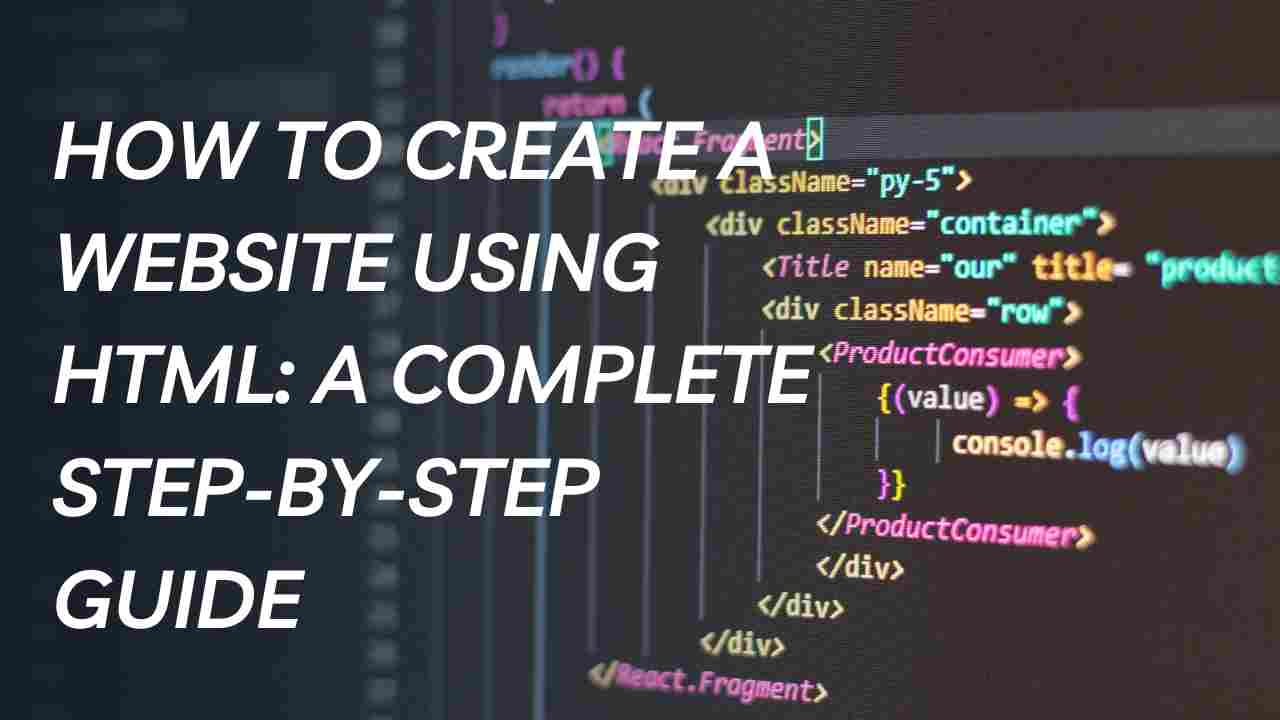Introduction
Creating a website is an essential skill in today’s digital age, whether you’re looking to build a personal portfolio, a blog, or even a business website. One of the most fundamental and effective ways to do this is by using HTML (Hypertext Markup Language). But how to create a website using HTML? What are the necessary steps, best practices, and tools to ensure your website is both functional and visually appealing? This comprehensive guide will take you through everything you need to know to build a website from scratch using HTML.
What is HTML?
HTML (Hypertext Markup Language) is the standard markup language used to create web pages. It provides the structure for content on the internet, including text, images, links, and multimedia elements.
Why Use HTML for Creating a Website?
- Easy to Learn: Ideal for beginners.
- Complete Control: Allows customisation at every level.
- SEO-Friendly: Provides clean, structured code for search engines.
- Browser Compatibility: Works across all web browsers.
Tools You Will Need
Before you start building your website, gather the following tools:
1. Text Editor
- Notepad (Windows)
- TextEdit (Mac)
- VS Code (Recommended)
- Sublime Text
2. Web Browser
- Google Chrome
- Mozilla Firefox
- Safari
- Microsoft Edge
3. Hosting Service (For Live Website)
- GitHub Pages (Free)
- Netlify (Free/Paid)
- Hostinger, Bluehost (Paid)
How to Create a Website Using HTML (Step-by-Step Guide)
Step 1: Setting Up Your Project Folder
- Create a new folder on your computer where all your website files will be stored.
- Name it something relevant, like “MyWebsite”.
Step 2: Creating Your First HTML File
- Open your preferred text editor (e.g., VS Code).
- Create a new file and save it as “index.html” inside your project folder.
- Add the basic HTML structure:
<!DOCTYPE html>
<html>
<head>
<title>My First Website</title>
</head>
<body>
<h1>Welcome to My Website</h1>
<p>This is a simple website created using HTML.</p>
</body>
</html>
- Save the file.
Step 3: Viewing Your Website
- Open your index.html file with any web browser (Right-click > Open with > Choose your browser).
- You should see a basic webpage with a heading and a paragraph.
Step 4: Adding More HTML Elements
To make your website more engaging, you can add various HTML elements:
Headings
<h1>Main Heading</h1>
<h2>Sub Heading</h2>
<h3>Smaller Heading</h3>
Paragraphs
<p>This is a paragraph of text.</p>
Links
<a href=”https://www.example.com”>Visit Example</a>
Images
<img src=”image.jpg” alt=”Description of Image” width=”500″>
Lists
<ul>
<li>Item 1</li>
<li>Item 2</li>
<li>Item 3</li>
</ul>
<ol>
<li>First Item</li>
<li>Second Item</li>
<li>Third Item</li>
</ol>
Step 5: Creating Multiple Pages
- Create another file named “about.html”.
- Add the following code:
<!DOCTYPE html>
<html>
<head>
<title>About Page</title>
</head>
<body>
<h1>About Me</h1>
<p>This is the about page of my website.</p>
<a href=”index.html”>Back to Home</a>
</body>
</html>
Step 6: Linking Pages Together
Update your index.html file to include a link to your about.html page:
<a href=”about.html”>About Me</a>
Step 7: Adding Style with CSS
To make your website more visually appealing, you can add CSS (Cascading Style Sheets).
<head>
<title>My Styled Website</title>
<style>
body {
font-family: Arial, sans-serif;
background-color: #f0f0f0;
margin: 0;
padding: 20px;
}
h1 {
color: navy;
}
p {
color: darkslategray;
}
</style>
</head>
Step 8: Making Your Website Live
To make your website accessible to everyone, you need to host it online.
- GitHub Pages: Free and simple for static websites.
- Netlify: Offers free and premium hosting.
- Paid Hosting Services: Bluehost, Hostinger, SiteGround, etc.
Best Practices for Creating a Website Using HTML
- Use Semantic HTML: Ensure your code is well-structured.
- Keep Your Code Clean: Indent properly and comment where necessary.
- Use External CSS and JavaScript Files: For better performance and maintainability.
- Make It Responsive: Use media queries for mobile optimization.
- Test Across Browsers: Ensure compatibility with Chrome, Firefox, Safari, and Edge.
Conclusion
Learning how to create a website using HTML is the first step towards building a strong online presence. With a basic understanding of HTML, you can create impressive and functional websites from scratch.
Continue building your skills by learning CSS and JavaScript to enhance your projects. Start coding today and bring your ideas to life!








10 thoughts on “How to Create a Website Using HTML: A Complete Step-by-Step Guide”
Nice post. I was checking continuously this blog and I’m impressed!
Very helpful information specially the last part 🙂 I care for such info much.
I was seeking this particular information for a very
long time. Thank you and good luck.
ini adalah situs bokep paling bagus
Wonderful article! We will be linking to this
particularly great post on our site. Keep up the
great writing.
70918248
References:
other names for anabolic steroids – Kathie –
What’s up everyone, it’s my first pay a visit at this site, and article is genuinely
fruitful for me, keep up posting these posts.
There’s certainly a lot to know about this topic.
I like all of the points you’ve made.
Wonderful items from you, man. I’ve take note your stuff previous to and
you are just extremely wonderful. I actually like what you’ve obtained here, really like what
you’re stating and the way in which in which you are saying it.
You’re making it entertaining and you continue to take care of to keep it sensible.
I can’t wait to learn far more from you.
That is actually a terrific website.
I’m not that much of a internet reader to be honest but your sites really nice,
keep it up! I’ll go ahead and bookmark your site to come
back later. Cheers
70918248
References:
what is a natural steroid (navar.live)
70918248
References:
where can i buy steroids to build muscle, tempd.ru,
Comments are closed.